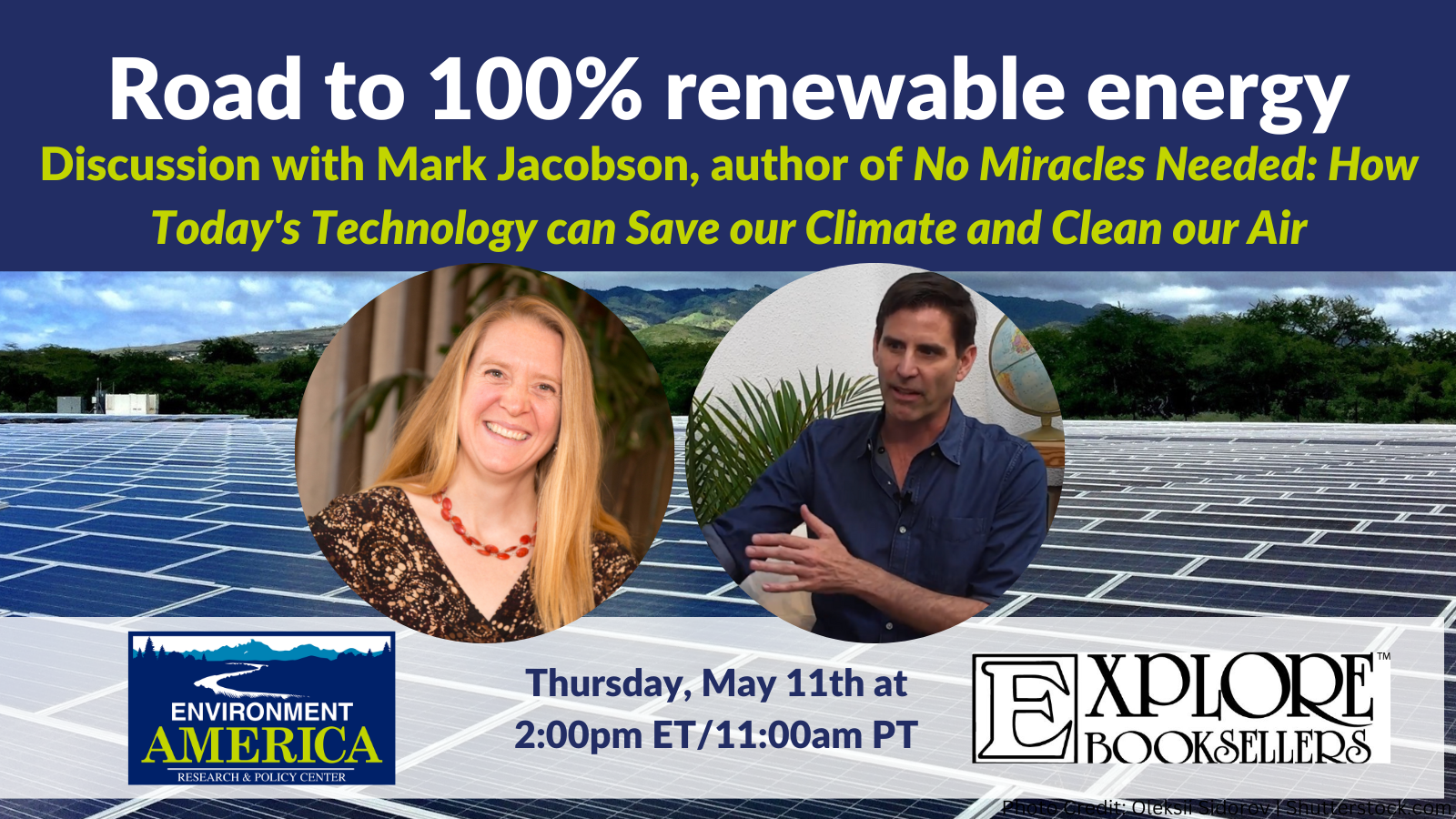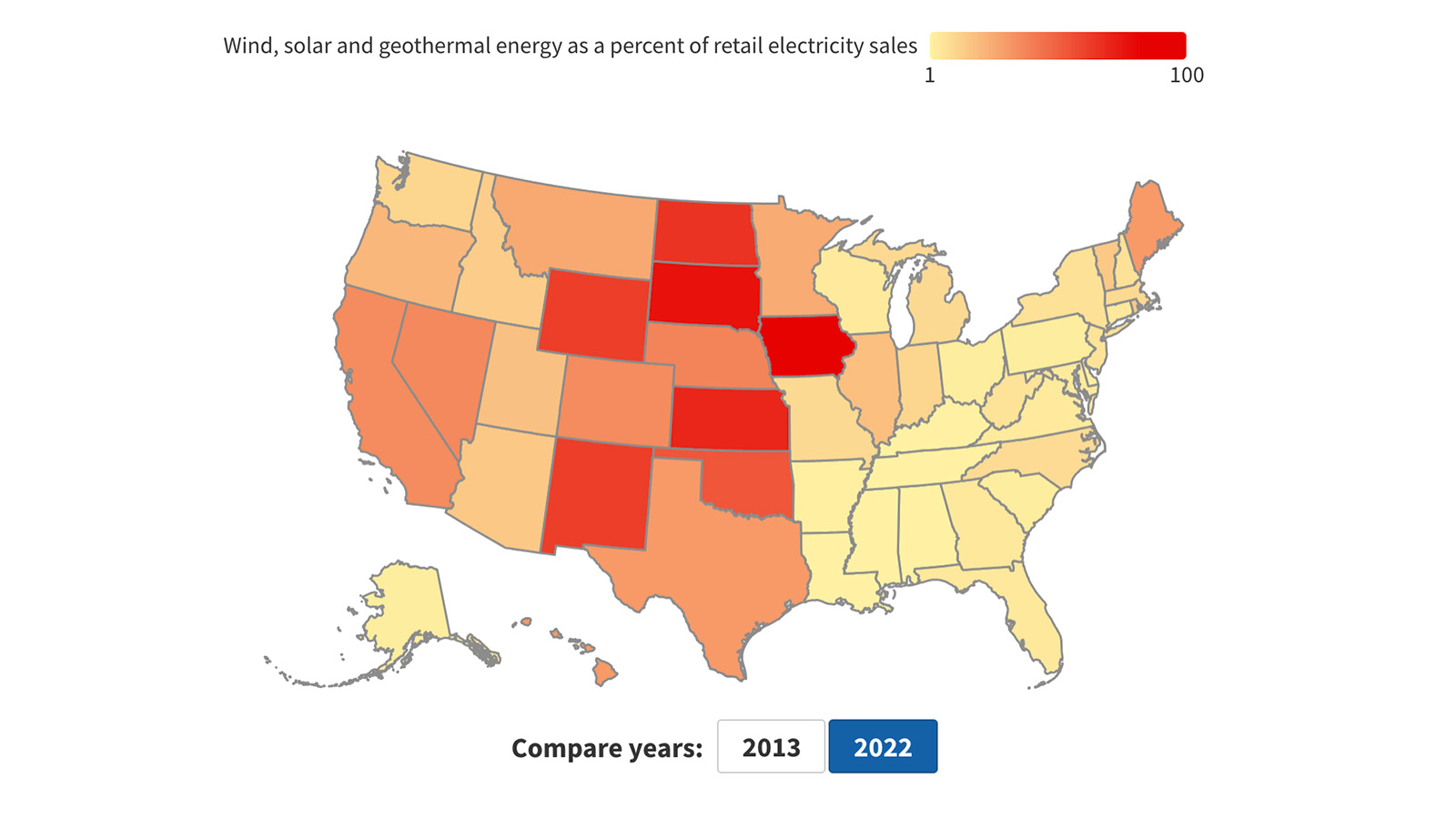
A New Way Forward
Envisioning a Transportation System Without Carbon Pollution
America has made progress in cutting pollution from cars and trucks over the last decade as a result of improved vehicle fuel economy and slower growth in driving. But eliminating greenhouse gas emissions from our urban transportation systems is going to require more than incremental change – it will require transformation.
World leaders made a bold commitment at the 2015 Paris climate talks to limit global warming to 2° Celsius above pre-industrial levels, with an aspiration to limit temperature rise to 1.5° Celsius. Fulfilling that promise will require the United States to reduce emissions of greenhouse gases starting now, with reductions exceeding 80 percent by mid-century.
America’s transportation system produces more greenhouse gas pollution than any entire nation in the world other than China, India and Russia. Reducing pollution from transportation in the U.S. is essential to prevent the worst impacts of global warming.
America has made progress in cutting pollution from cars and trucks over the last decade as a result of improved vehicle fuel economy and slower growth in driving. But eliminating greenhouse gas emissions from our urban transportation systems is going to require more than incremental change – it will require transformation.
The good news is that transformation to a zero-carbon transportation system is possible. New technologies and emerging social trends make it easier to envision a transition to a zero-carbon transportation system than ever before.
By employing smart strategies to repower our vehicles with electricity, reduce growth in vehicle travel, and optimize the efficiency of our transportation network, America’s urban areas can reduce energy demand for light-duty vehicles by as much as 90 percent below anticipated levels by 2050.
Now is the time for federal, state and local officials in the U.S. – as well as citizens and the private sector – to adopt the policies and tools that can enable America to transition to a zero-carbon urban transportation system by the middle of the 21st century.
A zero-carbon transportation system is possible.
The past decade has seen dramatic advances in technology that are transforming transportation. New shared mobility services, improved electric vehicles, and advances in information technology and technologies for autonomous vehicles open up new avenues by which America can pursue decarbonization of our transportation system. At the same time, renewed interest in walkable communities and broad demographic shifts create new opportunities for building sustainable, low-carbon communities.
America has the tools it needs to transition to a zero-carbon transportation system – and to do it in time to prevent the worst impacts of global warming. Among those tools are:
Repowering Vehicles: Efficient electric vehicles that can be powered by clean, renewable electricity are entering the marketplace faster than the hybrid cars of a decade ago and technology continues to improve, reducing costs and increasing travel range. Electric vehicles reduce carbon emissions using electricity from today’s grid, and will deliver greater benefits in the years to come as America transitions to electricity provided by clean, renewable sources of energy.
Urbanization and Smart Growth: American cities – especially their downtowns – are experiencing a renaissance, driven by demographic changes and a desire for walkable living among young people and others. A future in which most new development takes place in urban and walkable neighborhoods could reduce transportation greenhouse gas emissions by 9 to 15 percent by mid-century, according to research by the Urban Land Institute.
Shared Mobility: Over the last decade, an explosion of technology-enabled services – from carsharing to bikesharing to Lyft and Uber – has revolutionized transportation in many cities. Some of these “shared mobility” services have been shown to reduce vehicle ownership and driving, while the effects of others are just beginning to be studied.
Public Transportation: Transit ridership hit a modern high in 2014, the result of recent transit expansion projects and growing urban population and employment. Current public transportation services reduce vehicle travel (and GHG emissions) by about 10 percent in U.S. cities, according to research conducted for the Transportation Research Board.
Reallocating Space: The vast majority of street space in American cities is devoted to moving or storing cars, pushing people who walk, bike or take transit to the margins. Cities in the United States and around the world are reallocating space formerly devoted to cars to other public purposes, encouraging the use of low-carbon modes of transportation. U.S. cities with good bicycling infrastructure have nearly twice as many bike commuters as the national average.
Smart Pricing: Americans typically pay nothing to drive on most roads and enjoy the lowest gas taxes in the industrialized world. Government subsidies for driving and free access to roads create economic signals that encourage Americans to drive and put competing low-carbon transportation modes at an economic disadvantage. Cities around the world have shown that smart pricing policies can reduce congestion and encourage the use of low-carbon modes of travel.
Walking and Biking: Americans prefer walking to any other mode of transportation, according to a recent survey, and the number of people traveling by bicycle in many cities has grown dramatically in the last decade. The Institute for Transportation and Development Policy estimates that bicycling alone could curb global carbon dioxide emissions from transportation by 11 percent by 2050.
Information Technology: Advances in technology are enabling Americans to plan, schedule and pay for trips via low-carbon modes as easily as traveling by car. Real-time transit information has already been shown to trigger modest increases in transit ridership.
Driverless cars can potentially be deployed in ways that can be supportive of efforts to reduce greenhouse gas emissions – especially if they facilitate the use of shared mobility services, vehicle electrification and smart pricing, and do not undermine other emission-reduction strategies.
Numerous academic, non-profit and government studies have shown that large-scale reductions in carbon pollution from transportation are technically possible in the next three decades. New transportation technologies and tools create the opportunity for even greater emission reductions, if they are implemented intelligently.
Transformational change is possible.
Our current, auto-dominated transportation system seems like it has been with us forever, but it is largely the product of rapid, transformational change that occurred over the course of just a few decades in the mid-20th century. Transformational change can occur through incremental steps that grow in ambition and scope over time or through dramatic policy shifts that occur during narrow windows of opportunity.
There are many possible pathways for transforming our transportation system to eliminate greenhouse gas pollution:
- Some cities might choose to build up, expanding the availability of housing and commercial space in dense, transit-oriented neighborhoods and investing in robust public transportation systems to accommodate growth and reduce reliance on personal cars.
- Other cities might fix up – employing scarce resources to regrow walkable neighborhoods that have fallen victim to disinvestment and decay. Creating grassroots shared-economy services and shifting spending from highway expansion to urban infrastructure repair and reinvestment can help these cities to become the focus of future low-carbon development in their regions.
- Growing cities might link up, using public transportation to facilitate the growth of walkable communities and slow the onrush of sprawl. These cities might choose to advance electrification of their transportation system, taking advantage of locally abundant supplies of clean, renewable energy.
- Still other growing cities might sync up – developing systems of shared, driverless and connected cars that are managed for optimal environmental performance and efficient use of existing infrastructure. Areas no longer needed for parking could be repurposed to support the development of pleasant, walkable communities in areas formerly famous for sprawl.
Smart strategies can reduce light-duty vehicle energy demand in urban areas roughly 90 percent by 2050, enabling our transportation system to operate efficiently on clean, renewable energy.
New transportation tools and strategies reduce greenhouse gas emissions by curbing growth in vehicle travel; shifting travel to vehicles and modes powered by zero-carbon sources, such as efficient electric vehicles powered by renewable energy; and employing vehicles in ways that maximize energy efficiency.
- Changes in transportation investments and behavior consistent with the narratives presented in this report could reduce per-capita light-duty vehicle travel in four major U.S. metro areas by 28 to 41 percent, resulting in changes in total light-duty vehicle travel of -10 percent to +8 percent (compared to 2010 levels) in those areas by 2050.
- Transitioning to efficient electric vehicles could further reduce energy consumption in light-duty vehicles, as could taking advantage of the potential for shared fleets of driverless cars to adopt lightweight vehicle designs, “rightsized” to meet the specific demands of individual trips, and operated in ways that optimize energy efficiency.
- The combined effect of these three steps could be to reduce light-duty vehicle energy demand by 89 to 91 percent compared to 2010 levels – enabling our transportation system to be powered by clean, renewable forms of energy.
- Transforming transportation can play a supporting role in helping other sectors of the economy to decarbonize – providing a source of energy storage to support the integration of renewable sources of energy to the grid, and reducing “upstream” greenhouse gas emissions from oil and gas production, processing and transportation.
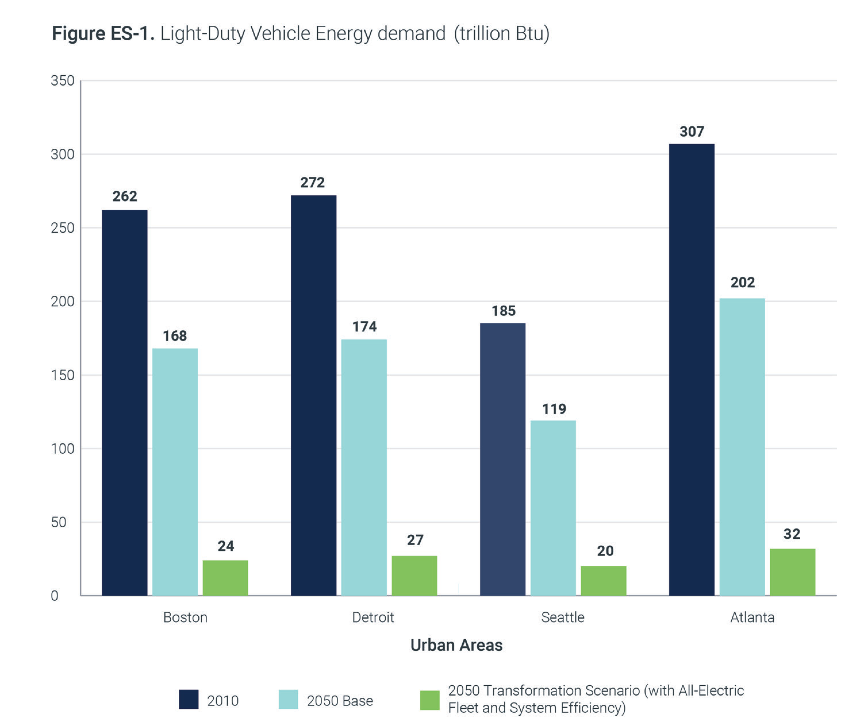
The transition to a zero-carbon transportation system won’t happen on its own, and there is no guarantee that technological change alone will get the job done. Achieving a zero-carbon transportation system that delivers the greatest possible benefits for America will require a fresh approach to transportation policy. Important steps include:
- Adopting greenhouse gas targets for transportation and evaluating infrastructure investments and transportation policy choices for their climate impacts.
- Shifting the emphasis of transportation policy from infrastructure construction to systems management – enabling transportation agencies to maximize the potential of today’s emerging information technology systems and shared mobility tools to improve the efficiency of the transportation network.
- Empowering local leadership, recognizing that metropolitan areas may pursue different pathways to decarbonization based on their distinct histories, cultures, built environments and community aspirations.
- Emphasizing “win-win-win” reforms that support multiple strategies for decarbonization. Smart land-use policies, for example, unlock the potential for several low-carbon modes of transportation – from walking to carsharing – and can support efforts to repower our transportation system with clean sources of energy.
- Ensuring quality transportation service and accessibility for all, recognizing that a zero-carbon transportation system must provide transportation options for people of all ages, abilities and income levels.
- Turbocharging innovation, through aggressive technology standards that drive progress in vehicles and fuels and an embrace of pilot projects and innovative service offerings that provide opportunities to test out new transportation ideas and prepare the public for change.
- Recognizing the co-benefits of transforming transportation. The same tools that can be used to transform transportation for the benefit of the climate can also be used to achieve an array of other important goals – saving taxpayers and consumers money; reducing air pollution, vehicle crashes and other public health and safety threats; ensuring fair and equitable access to transportation; and more. These benefits should be considered and taken into account as policy-makers consider steps toward transforming transportation.
Topics
Find Out More

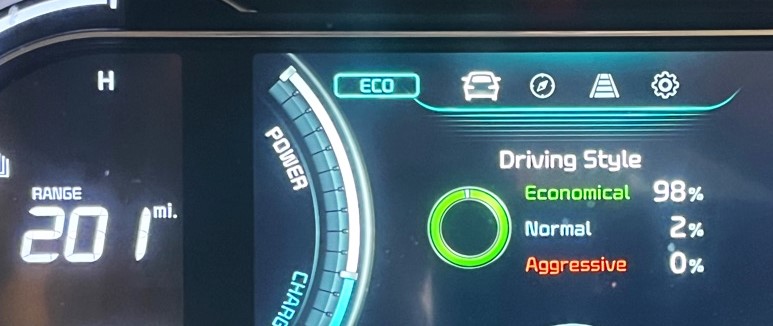
Electric vehicles are good. We can make them better.
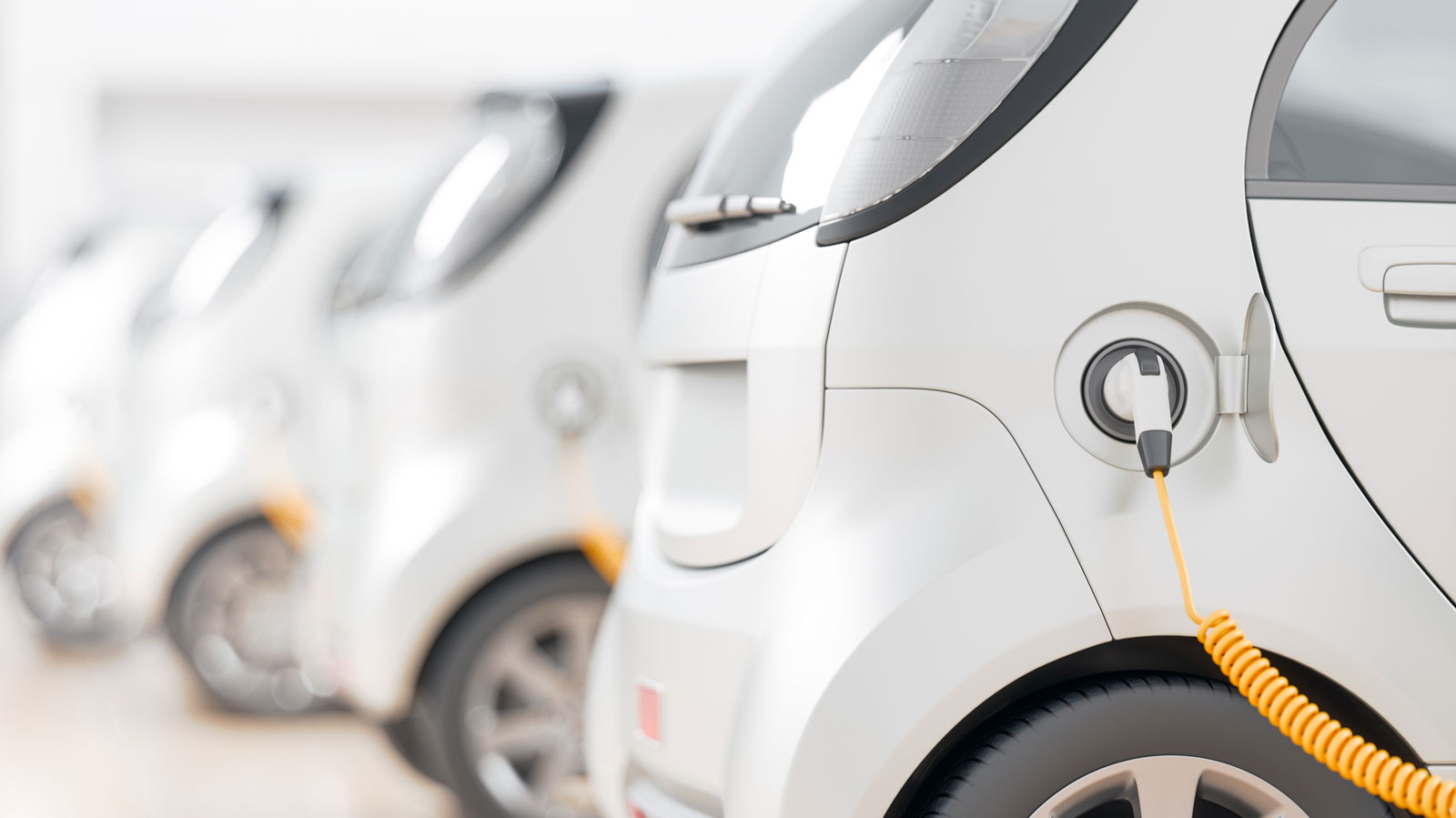
Electric Vehicles Save Money for Government Fleets
